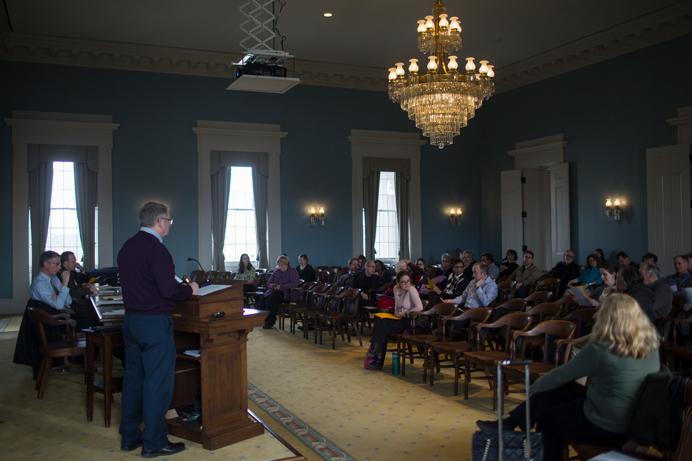Faculty hear inclusion push
Participants in Building University of Iowa Leadership for Diversity initiative are reaching out to learn how to work with gender nonconforming students.
March 21, 2017
As societal attitudes toward the LGBTQ community shift, the University of Iowa aims to continue building an inclusive environment.
The Building University of Iowa Leadership for Diversity initiative offers UI faculty and staff an opportunity to participate in workshops. From these workshops they earn a certificate that showcases their efforts to create an environment in the classroom and workplace that invites diversity, equity, and inclusion.
UI communication-studies graduate fellow Audrey Scranton, who studies identity development of young adults and social-justice issues in communication, gave a presentation at Tuesday’s Faculty Senate meeting in the Old Capitol Senate Chamber seeking feedback from faculty regarding how to integrate such knowledge among faculty.
“In order to make sure that we are not perpetuating discrimination without knowing, it is our responsibility as staff and faculty [to use] whatever influence we have at the university to best contribute to an inclusive environment, to take the knowledge and burden of awareness on ourselves,” she said.
Scranton said students who identify as transgender face a variety of barriers in college, such as changing legal records to reflect their gender identity, uncertainty about which bathroom to use without facing violence, and answering prying questions, among other issues.
The presentation focused specifically on transgender awareness and culminated in a brief workshop session in which faculty members turned to others sitting nearby to discuss their knowledge of interacting with transgender students as well as things they would like to understand better.
In recent years, the UI has made changes to better serve students with diverse gender identities. Signs on more than 100 single-user restrooms was changed to make them gender-neutral last summer, and at the start of this school year, in August 2016, the UI rolled out a change on MyUI allowing students to update their preferred name, gender, and pronouns.
Cassie Barnhardt, a UI assistant professor of education, said another way inclusiveness can be encouraged in the classroom is to socialize students by having the instructor do things such as announce their preferred pronouns or giving students the opportunity to state their preferred pronouns during introductions at the beginning of the semester.
UI law Professor Tom Gallanis said that given the interactive nature of classes in the College of Law, it is important to know what pronouns to use to call on students.
The problem with the MyUI updates, Gallanis said, is that instructors are not alerted on MyUI every time students update their information — for example, if students choose to update the information after the first day of class.
“I’m very glad that our computer systems now allow students to identify their preferred pronouns, but nobody could tell me how that information is designed to be transmitted to the faculty teaching in the classrooms,” he said.
While not all people who identify as transgender undergo sex reassignment surgery, the lack of knowledge about the long-term effects of transitioning concerned one Faculty Senate member. He said there seemed to be incompatibility between recognizing there are risks in the unknown and the efforts to be inclusive of everyone.
Diversity resources coordinator Kendra Malone, who works on the Safe Zone Project, said long-term information is largely unavailable because it hasn’t been safe to come out as gender nonconforming due to discrimination, but combating this attitude to make a safe learning environment for students is the priority.
“Trans students from across the nation and comparable institutions have said these are the problems that we’re facing, and these are the things that we need faculty to do right now to make us safe and comfortable in our work environments while we also move to the research piece,” she said.



